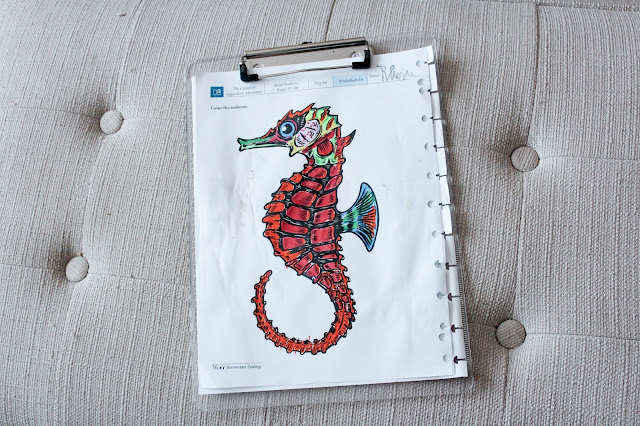Family Style Homeschooling - Adapting Elementary Zoology from Master Books
**I made a YouTube video going over this topic, if you'd prefer to watch instead of read, scroll to the bottom**
I would absolutely love a full on one room school house vibe, but in our homeschool that just hasn't been reality. While there are days we all work on our independent subjects gathered around the table, more often I pull kids in to the school room individually for math and language. Because of this I really cherish our Morning Basket time, and I choose to combine my kids in subjects like History and Science.
I love when we all learn together, when the kids happily chat about their communal lessons, and when there is a sense of camaraderie in our homeschool.
There are plenty of multi-level history and science programs available in the homeschool market, but I struggled to find one that checked all our boxes. So I choose to adapt Master Books courses and use them Family Style.
I worried that this would mean a lot of extra work on my part, and time that I just didn't want to prioritize to use for lesson planning, but to my delight I haven't found that to be the case at all.
A quick synopsis of the Elementary Zoology course from the back of the Teacher Guide:
"Zoology is the study of life, often connected with biology and focused on animals, which is why we have those places called "zoos" all across the country. However, while the secular focus of zoology is on life origins and evolution, this course celebrates the wonder of God's creation and His unique design of all life on earth. This course has been developed to enhance learning about the diverse and amazing animals we see in our world. From the tiniest to the largest, you will be exploring what makes them unique as you celebrate their place in the world God created."
This course was designed for roughly a 4th - 6th grade level. The lessons are designed to take approximately 30-45 minutes, five days a week. It is scheduled for 36 weeks.
The set available from Master Books includes five books: How Many Animals Were on the Ark?, God's Amazing Creatures and Me, The Complete Aquarium Adventure, The Complete Zoo Adventure, and God's BIG Book of Animals. The set also includes the Teacher Guide which is where you will find the student worksheets, quizzes, weekly lesson schedule, and answer keys.
I'm using this course with a 3rd, 2nd, Kinder, and Preschooler. For our particular needs, we purchased two Teacher Guides, and one set of books. I like to have a TG for each child who will be completing a decent percentage of the worksheets because I honestly despise making copies, and find it so much easier to have them ready to go. I didn't feel the need to have multiple copies of the actual books, and we have all been sharing them without issue.
Tip: I like to combine my Teacher Guides for each subject into a larger guide with both copies. This definitely is an investment of time initially, but it makes life so much simpler for me in the long run. I can open the book and grab both copies of whatever worksheet we're working on and pass them out without having to flip through multiple copies. It might not seem like a lot, but it makes a difference. However, as SOON as my children are comfortable working directly out of their books, I will abandon this practice and each child will just have their workbook. I so look forward to this! So if your children don't need worksheets removed to be able to focus / not get overwhelmed, for your own sanity disregard this tip lol.
We fit this in during our Morning Time. You could call it a morning collective, morning basket, circle time... whatever. This is the time we gather together to start our day. We start with Bible, a hymn or worship song, and prayer. Then I read aloud for 15-20 minutes before we transition into our "Loop" subjects. For us that is history, science, geography, and art. Zoology falls on Tuesdays and Thursdays.
(Yes it is early November and I have switched out our rug to my "winter" one and put up some Christmas. Controversial I know, but I've always been an early Christmas decorator and never regretted it!)
We pile onto the couch and usually have a basket of pencils, crayons, markers, etc on the ottoman. I give each of my older kids a clipboard with their worksheet for the day, and the younger ones too if they are going to be participating. There are often coloring pages, connect the dots, and similar activities that both my kinder and preschooler enjoy doing.
We've also added in the Marvels of Creation series, which is included in the Family Morning Basket from Master Books. I don't try to line animals up or anything, although you totally could. I just go in order and read about one animal, and then we move to whatever is scheduled in Zoology. Ultimately this just provides a way for the younger ones to participate and be engaged more.
Even though we don't actively try to line anything up sometimes there are happy coincidences, like learning about Porcupines on the same day and the Long-Spine Porcupinefish.
While I read from Marvels of Creation, everyone uses a primary composition book to draw a picture of the animal we are studying. Then my children either write or dictate a narration of what they learned. Sometimes it is just a few facts, other times they go into great detail. I'm am happy with either outcome, although I do expect to see more from my 9 year old than my 5 year old!
My preschooler just listens throughout the lesson. Colors or draws and then spends the rest of time either looking at books or doing something quiet with his hands.
Favorites of his are legos, wood blocks, Lincoln logs, magna-tiles, cars, train tracks, or play-doh. All of these keep him fairly engaged and able to listen without becoming disruptive.
As we move in to the Zoology lesson my Kindergartner also just listens in. If she has a copy of the worksheet for the day, she'll color or work on whatever that activity is, otherwise she will do something quietly. She most often chooses to take care of her baby doll while listening.
My 2nd grader completes most of the worksheets as written, however we often discuss "fill in the blank" and short answer questions verbally instead of her writing the answers. I adapt for her as needed.
My 3rd grader completes the course as written. We may occasionally skip a worksheet or allow for her to answer verbally or tweak an assignment to work better for us. That is part of the beauty of homeschool, that we can adapt and craft it to be just what we need. However, I'm also grateful that this course doesn't need much in the way of adapting for us!
That's it. Adapting Elementary Zoology to use Family Style is really very simple. It doesn't take much on my part at all. There is a great mix of worksheets that work for all of my kids, as well as games and hands-on activities that everyone gets in on.
What do you use for science? Are you a fan of family style teaching, or do you prefer an individual course for each child? I'd love to hear about what works for your family!
As promised at the beginning of this post, here is my YouTube video on how we adapt Elementary Zoology to fit our Family Style schooling.
















Comments
Post a Comment